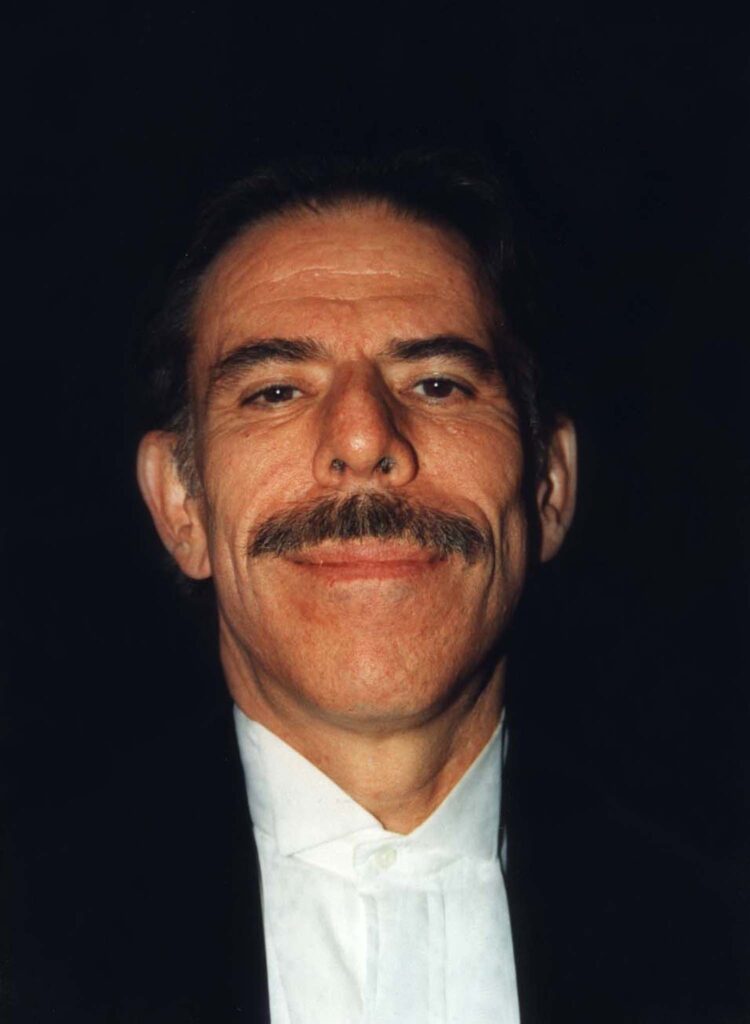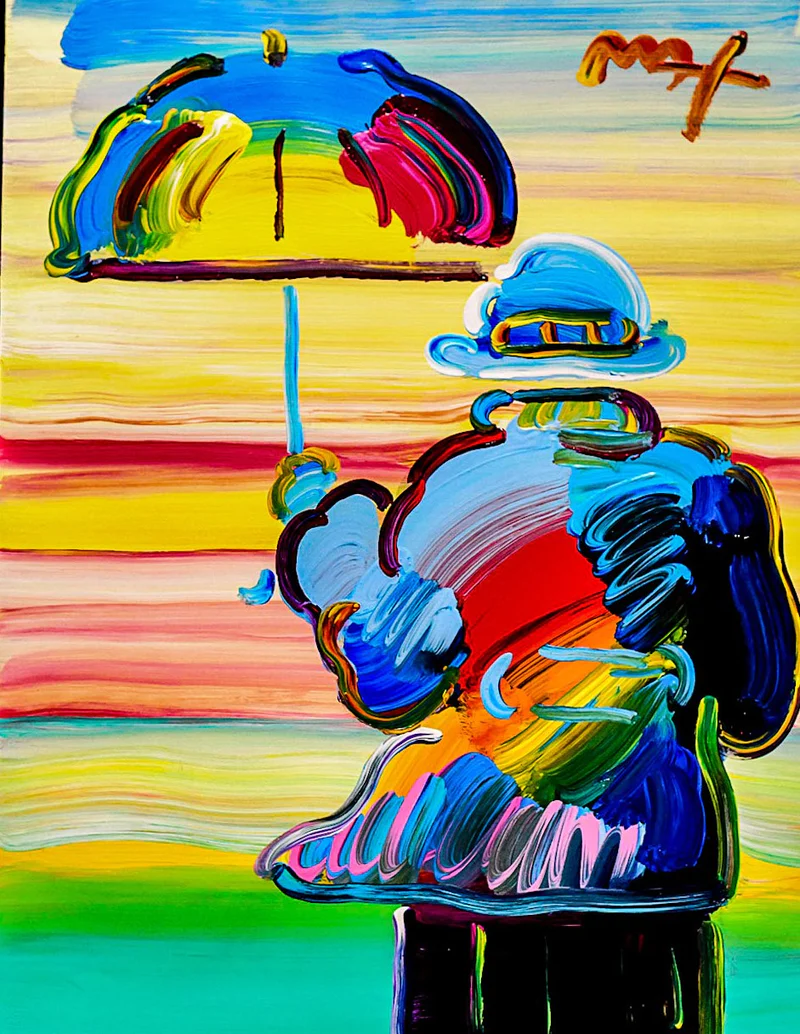Picture this: you’re standing in front of a painting that seems to dance with color and energy, captivating your senses and whisking you away to a world of imagination. That’s the magic of Peter Max’s “Umbrella Man.” In this journey, we’ll delve into the life and career of Peter Max, uncover the essence of “Umbrella Man,” and explore some intriguing facets of this iconic artwork.
Who was Peter Max?

Imagine a young boy with an insatiable curiosity and a natural talent for art, growing up in the vibrant city of Berlin, Germany. That boy was Peter Max. Born on October 19, 1937, Max’s early years were colored by the turmoil of World War II. His family’s journey took them from Berlin to Shanghai, where Max’s love for art began to blossom. In 1953, the Max family immigrated to the United States, settling in New York City. It was there that Peter Max’s artistic journey truly took flight.
FUN FACT: Peter Max was the official artist for five Super Bowls! His dynamic and visually striking artwork was featured on the official posters for Super Bowls XXXVI, XXXVII, XXXVIII, XXXIX, and XL.
Max’s Career
Fast forward to the 1960s, a decade marked by social upheaval, cultural revolution, and boundless creativity. Against this backdrop, Peter Max emerged as a visionary artist whose bold, colorful creations captured the spirit of the times. His art became a visual anthem for the counterculture movement, embracing themes of peace, love, and harmony. Max’s unique style, characterized by vibrant hues, cosmic imagery, and intricate patterns, set him apart as a leading figure in the pop art movement.
As the ’60s gave way to the ’70s and beyond, Peter Max continued to push the boundaries of artistic expression. From iconic album covers to larger-than-life murals, his work adorned galleries, museums, and public spaces around the world. Max’s collaborations with renowned brands and his dedication to spreading messages of positivity cemented his status as a cultural icon.
What is happening in Umbrella Man?

| Artist | Peter Max |
| Date Created | 1972 |
| Medium | Acrylic on canvas |
| Genre | Pop Art |
| Period | Contemporary |
| Dimensions | 36″ x 24″ inches |
| Series / Versions | Original |
| Where is it housed? | Private Collection |
Now, let’s step into the world of “Umbrella Man.” Close your eyes and envision a figure standing amidst a whirlwind of color and motion, holding aloft a vibrant umbrella that seems to radiate with energy. The scene is alive with swirling patterns, cosmic shapes, and a kaleidoscope of hues that draw you in with their irresistible charm.
At the heart of “Umbrella Man” is the titular figure, an enigmatic presence imbued with a sense of strength and serenity. Clad in colorful attire and sheltered beneath the protective canopy of the umbrella, this central character exudes an aura of quiet confidence. Surrounding the figure are layers of dynamic shapes and lines, each contributing to the overall sense of movement and vitality.
The umbrella itself serves as a powerful symbol within the composition, representing not only physical protection from the elements but also a metaphorical shelter from the storms of life. It speaks to the universal human experience of seeking refuge and finding solace in the midst of chaos. In the world of “Umbrella Man,” colors dance and shapes swirl, inviting viewers to immerse themselves in a realm where joy and optimism reign supreme.
Interesting Facts about Umbrella Man
Inspired by Jazz: Peter Max’s love for jazz music permeates many of his artworks, including “Umbrella Man.” The rhythmic energy and improvisational spirit of jazz find expression in the dynamic composition of the painting.
Iconic Umbrella Motif: Throughout his career, Max frequently incorporated umbrellas into his art as symbols of protection and unity. “Umbrella Man” stands as one of the most iconic manifestations of this recurring motif, serving as a visual anchor within the vibrant tapestry of the painting.
Spreading Peace and Love: In an era defined by social and political turbulence, Peter Max used his art as a platform to promote messages of peace, love, and understanding. “Umbrella Man” embodies these ideals, inviting viewers to embrace hope and optimism in the face of adversity.
Color Explosion: One of the hallmarks of Peter Max’s artistic style is his bold and expressive use of color. In “Umbrella Man,” the canvas comes alive with a riot of vibrant hues that captivate the eye and ignite the imagination. Each brushstroke serves to amplify the sense of joy and vitality that permeates the painting.
Artwork Spotlight: Giving of One’s Self

“Giving of One’s Self“by Peter Max is an expressive work of art that potently mixes vivid colors with deep themes. It paints the picture of altruism and compassion, making the viewers feel attracted to the beauty of selflessness.
Frequently Asked Questions
Who painted the umbrella man?
The Umbrella Man frequently appears as a character in the art of renowned American pop artist Peter Max. Typically portrayed donning a vibrant raincoat, clutching an umbrella, and standing amidst a downpour, this character is a recurring motif in Max’s body of work.
Did Peter Max work with The Beatles?
There is a common misconception that Max was the creator of the designs for The Beatles’ famous 1968 animated film “Yellow Submarine.” Although his cosmic artwork shares similarities with the film’s iconic aesthetic, Max’s involvement was limited to providing early consultation for the project.
Conclusion
As we reflect on the vibrant tapestry of “Umbrella Man,” we are reminded of the enduring power of art to transcend boundaries and connect us to the essence of our shared humanity. Through his visionary creations, Peter Max invites us to embark on a journey of exploration and discovery, where colors dance, shapes swirl, and the possibilities are limitless. In a world often fraught with uncertainty, “Umbrella Man” stands as a beacon of hope, reminding us that even in the darkest of storms, there is always light to be found.













